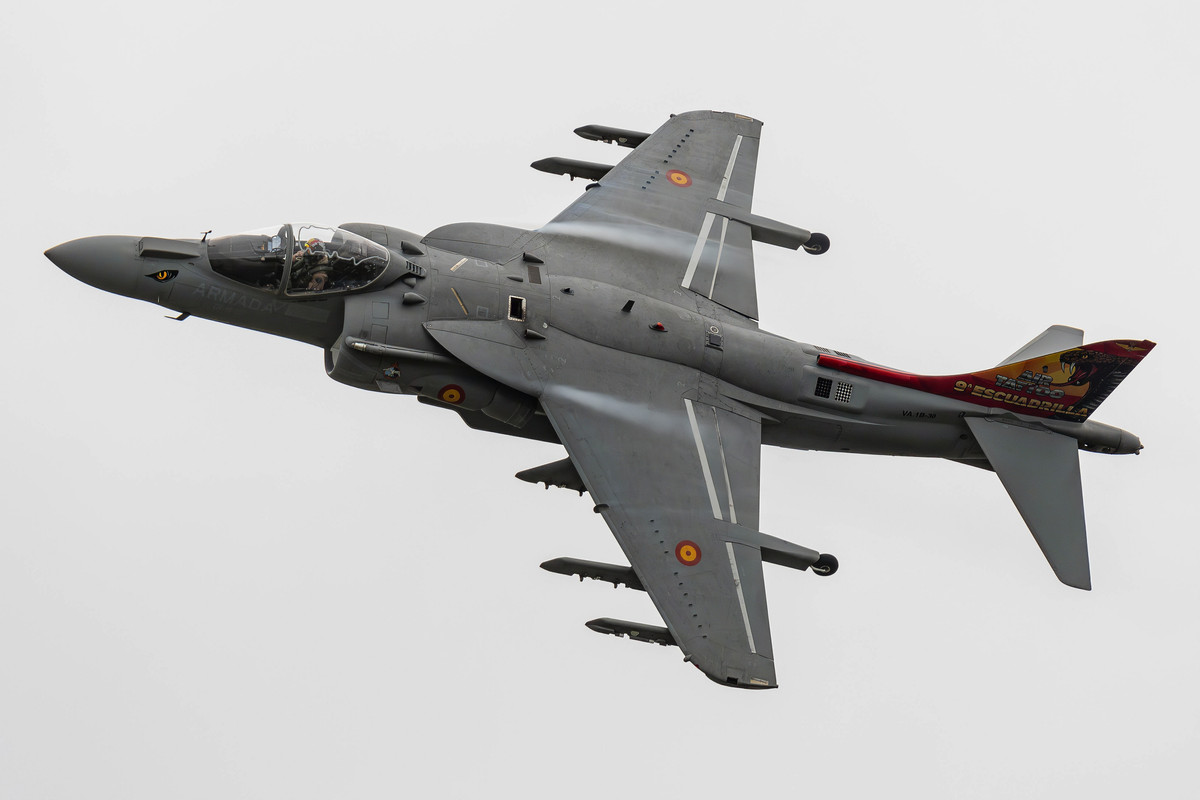
Spanish Navy AV-8B Harrier II Solo Display
Harrier Solo Display
The Spanish Navy AV-8B Harrier II Solo Display comes from the 9th Squadron (9 Escuadrilla), based at Rota Naval Base in southern Spain. This skilled team flies the EAV-8B Matador II+, a specialized variant of the AV-8B Harrier II, an aircraft renowned for its vertical or short takeoff and landing (V/STOL) capabilities. The display team consists of two highly trained demo pilots who alternate their performances, typically splitting duties across event days to showcase their expertise and the aircraft’s remarkable agility.
The display itself is a dynamic 10-to-13-minute routine that highlights the Harrier’s unique abilities. It begins with a short takeoff, quickly escalating into a series of high-speed passes filled with rolls and sharp turns, demonstrating the aircraft’s agility and power. This is followed by a slow pass along the crowdline, allowing spectators to appreciate the jet’s sleek design up close. The centerpiece of the show is a dramatic hover at show center, where the pilot showcases the aircraft’s exceptional stability and control—a hallmark of its V/STOL design. The performance wraps up with a climb away and a short landing (not vertical), emphasizing operational flexibility. Though the team only performs at one or two events per year—sometimes slightly more—these rare appearances make the Spanish Navy AV-8B Harrier II Solo Display a highly anticipated spectacle, even within Spain, leaving audiences in awe of both pilot skill and aircraft ingenuity.
About the AV-8B Harrier II
The AV-8B Harrier II is a single-engine ground-attack aircraft that represents the second generation of the Harrier family. Developed in the early 1970s, it emerged from a collaborative effort between the United States and the United Kingdom to overcome the operational limitations of the first-generation Hawker Siddeley Harrier. The AV-8B is distinguished by its vertical or short takeoff and landing (V/STOL) capabilities, enabling it to operate from small aircraft carriers, large amphibious assault ships, and forward operating bases. It is primarily employed for light attack or multi-role missions, including close air support for ground troops and armed reconnaissance. The aircraft is operated by the United States Marine Corps (USMC), the Spanish Navy, and the Italian Navy.
The AV-8B incorporates several advancements over its predecessor, such as a more powerful Rolls-Royce Pegasus engine, a larger composite wing with additional hardpoints, a reinforced airframe, and an elevated cockpit for improved pilot visibility. These enhancements increase its payload capacity, range, and operational effectiveness. Equipped with advanced avionics, the AV-8B can carry a diverse array of ordnance, including bombs, rockets, and guided missiles, making it adaptable to various combat scenarios. Its V/STOL capability allows it to be stationed closer to the front lines, reducing response times and enhancing tactical flexibility.
Throughout its service history, the AV-8B Harrier II has proven its versatility in numerous military and humanitarian operations. During the Gulf War in 1991, it was among the first USMC tactical strike platforms deployed to the theater, operating from expeditionary airfields and sea-based platforms. It completed 3,380 sorties during the ground war, achieving a mission-capable rate exceeding 90 percent. The aircraft also played significant roles in Operation Enduring Freedom in Afghanistan, the Iraq War, and Operation Odyssey Dawn in Libya. Its ability to deploy rapidly and function in austere environments has solidified its reputation as a valuable asset in modern conflicts.
Specifications
Crew
1
Length
46 ft 4 in (14.12 m)
Wingspan
30 ft 4 in (9.25 m)
Height
11 ft 8 in (3.55 m)
Max Speed
585 kn (673 mph, 1,083 km/h)
Range
1,200 nmi (1,400 mi, 2,200 km)
Service Ceiling
50,000 ft (15,000 m)
g limits
+8 to -3
Harriers in the Spanish Navy
The EAV-8B Matador II+ is a variant of the AV-8B Harrier II operated by the Spanish Navy, which became the first international customer for the aircraft. In 1983, Spain ordered 12 AV-8B aircraft to replace its aging AV-8S Matadors, designating them as the EAV-8B Matador II. In 1993, the Spanish Navy acquired eight AV-8B+ Harriers, known as the EAV-8B+ in service, and subsequently, in 2000, upgraded the remaining EAV-8B fleet to the same standard. The EAV-8B+ features a redesigned and larger fuselage, new wing fuel tanks, Rolls-Royce F402-RR-408 engines, and carbon-fiber composite leading edge root extensions wings. Its most notable enhancement is the AN/APG-65 pulse Doppler radar in the nose, which provides advanced multi-mode, all-weather, day-and-night capabilities for air-to-air and air-to-surface operations.
The Spanish Navy’s entire Harrier fleet is operated by the 9th Squadron (9 Escuadrilla), stationed at Rota Naval Base, and conducts missions from the Juan Carlos I amphibious assault ship. The squadron has logged over 50,000 flight hours with the Harrier II Plus, employing the aircraft for a wide range of tasks, including combat air patrols to protect naval task groups, armed reconnaissance, attacks on land and sea targets, close air support for ground forces, and helicopter escort duties. The EAV-8B Matador II+ enhances Spain’s naval aviation capabilities, offering a flexible and potent platform for power projection and support in diverse operational contexts.
The EAV-8B Matador II+ has become a cornerstone of the Spanish Navy’s air arm, leveraging its V/STOL capabilities to operate effectively from the Juan Carlos I. This allows the navy to deploy air support in maritime security operations and participate in international coalitions. The aircraft’s advanced radar and avionics systems bolster its performance in both offensive and defensive roles, ensuring its effectiveness across mission profiles. The Spanish Navy remains committed to maintaining this tactical asset, with ongoing upgrades planned to keep the EAV-8B Matador II+ operational and relevant into the future.
Did You Know?
- The AV-8B Harrier II is one of the few military jets capable of vertical takeoff and landing (VTOL). This allows it to launch from small aircraft carriers, amphibious assault ships, or even makeshift bases without runways, giving it unmatched versatility in combat situations.
- During the 1982 Falklands War, the Harrier was a game-changer for British forces. Operating from compact carriers, it downed 20 Argentine aircraft in air-to-air combat without losing a single Harrier to enemy planes, proving its combat prowess and reliability under pressure.
- The Harrier owes its ability to hover and perform VTOL to a clever thrust vectoring system. By redirecting engine exhaust through rotating nozzles, it can precisely control its direction and altitude—think of it as a jet that can dance in the sky, pulling off moves no traditional fighter can match.
- The Harrier’s VTOL capability has transformed military strategy by enabling rapid air power deployment in places where conventional runways aren’t an option. This flexibility has made it a key asset for operations in rugged or remote terrains.
- The AV-8B version boasts advanced avionics, better radar, and the ability to carry precision-guided weapons. These improvements have kept it relevant decades after its introduction, making it a multi-role powerhouse for missions like close air support and reconnaissance.
Test Your Knowledge
1. In what year did the AV-8B Harrier II officially enter service with the USMC?
































